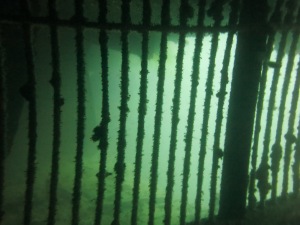It was only until i got to Coron that i realised the significant history of The Philippines and the war between the Japanese and the Americans. In September of 1944 the American’s sunk the Japanese supply fleet in Coron Bay. These were the wrecks i knew i wanted to dive. Arriving by bunga boat from El Nido after 9 hours i was pleasantly welcomed by Ricardo from Seadive Resort who talked us into staying there for the next few days.
For me, it was a perfect resort with a bar, restaurant, cheaper rooms and a dive shop; the one stop shop. Diving with Seadive was slightly more expensive then the other companies however, the guides were very professional, the boats were comfortable and it was all made very easy for the guests.
On the first day i dived 3 of the ‘easier’ wrecks with Nikko. The Kogyo Maru, a Japanese freighter carrying construction materials; a very exciting first dive of the day. With easy penetrations through the holds, engine room and bridge area you could also see a truck and bulldozer. Taiei Maru, was a different wreck as it has big empty cargo rooms which allowed for easy penetration. On this wreck Nikko made a point to see the 2 massive boilers; one which was blown up by a bomb! Olympia Maru freighter, personally my favourite of the day. With smaller swim throughs to penetrate through the wreck as well as more visible wreckage, it was more exciting for me.
The second day of wrecks was the more extreme. With depths and times exceeding deco, we had to spend a lot of time at the safety stop. Luckily it was myself, the guide and another instructor! First of the day; The Irako. It was an exhilarating dive, nothing that i had expected. We descended straight down to 42m underneath the boat, found a tiny hole and snuck in. It was the propeller shaft; a very narrow dark tunnel along the steering. Dark, deep, with no way out (a diver in-front and a diver behind) it got my heart racing. Just using our torches to make sure we were neutrally buoyant in the tunnel, it felt like we were in there a little too long. Finally, we saw some light, there was a way out, still at 42 m we squeezed through the hole which lead to a larger opening, we were inside the engine room slowly meandering out way through the vessel. The Irako had better visability then the other wrecks which helped to take in the sheer magnitude and size of the ship. We went 15 minutes into deco having to do a 20 minute safety stop!
Akitsushima was another that needed a lot of concentration. With very small holes to squeeze through, i was very glad to have a divemaster who knew his way around the ship. This ship was a seaplane tender with a huge crane now lying on its side along the sandy bottom, she was armed with many guns a long with many of the other war ships.
Okikiawa Maru was a Japanese tanker that was hit and sank in shallower waters which makes it an easier and longer dive for the less experienced. In some areas you had to have perfect buoyancy as we were swimming through very shallow walkways and holes, however most of the time the rooms are a lot larger. Most of these rooms were pitch black; just like doing a night dive. The outside of the wreck is covered in coral and fish which makes a beautiful wreck; i even spotted a turtle!
These wrecks truly were amazing; for any diver it should definitely be on your ‘diving bucket list’. Unfortunately because of the very low light and visability i wasn’t able to take many photo’s however it will be a memory i will forever hold in my mind.
If you want to read more about diving in The Philippines, check out Tubbataha!






I love diving… but wreck diving just freaks me out! 😀
Yea i can understand that!
But there are many shallow, light wrecks to start on; then i’m sure you’ll be hooked 😉
Pingback: Getting around the Philippines | The Travelling Mermaid